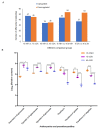Integrative Analysis of Metabolomics and Transcriptomics Reveals Molecular Mechanisms of Anthocyanin Metabolism in the Zikui Tea Plant (Camellia sinensis cv. Zikui)
- PMID: 35563169
- PMCID: PMC9103729
- DOI: 10.3390/ijms23094780
Integrative Analysis of Metabolomics and Transcriptomics Reveals Molecular Mechanisms of Anthocyanin Metabolism in the Zikui Tea Plant (Camellia sinensis cv. Zikui)
Abstract
In this study, we performed an association analysis of metabolomics and transcriptomics to reveal the anthocyanin biosynthesis mechanism in a new purple-leaf tea cultivar Zikui (Camellia sinensis cv. Zikui) (ZK). Three glycosylated anthocyanins were identified, including petunidin 3-O-glucoside, cyanidin 3-O-galactoside, and cyanidin 3-O-glucoside, and their contents were the highest in ZK leaves at 15 days. This is the first report on petunidin 3-O-glucoside in purple-leaf tea. Integrated analysis of the transcriptome and metabolome identified eleven dependent transcription factors, among which CsMYB90 had strong correlations with petunidin 3-O-glucoside, cyanidin 3-O-galactoside, and cyanidin 3-O-glucoside (PCC > 0.8). Furthermore, we also identified key correlated structural genes, including two positively correlated F3’H (flavonoid-3′-hydroxylase) genes, two positively correlated ANS (anthocyanin synthase) genes, and three negatively correlated PPO (polyphenol oxidase) genes. Overexpression of CsMYB90 in tobacco resulted in dark-purple transgenic calluses. These results showed that the increased accumulation of three anthocyanins in ZK may promote purple-leaf coloration because of changes in the expression levels of genes, including CsMYB90, F3’Hs, ANSs, and PPOs. These findings reveal new insight into the molecular mechanism of anthocyanin biosynthesis in purple-leaf tea plants and provide a series of candidate genes for the breeding of anthocyanin-rich cultivars.
Keywords: anthocyanin metabolism; association analysis; metabolomics; purple-leaf tea plant; transcriptomics; ‘Zikui’.
Conflict of interest statement
The authors declare no conflict of interest.
Figures







Similar articles
-
Metabolome and Transcriptome Analysis Reveals Putative Genes Involved in Anthocyanin Accumulation and Coloration in White and Pink Tea (Camellia sinensis) Flower.Molecules. 2020 Jan 2;25(1):190. doi: 10.3390/molecules25010190. Molecules. 2020. PMID: 31906542 Free PMC article.
-
Metabolome and Transcriptome Sequencing Analysis Reveals Anthocyanin Metabolism in Pink Flowers of Anthocyanin-Rich Tea (Camellia sinensis).Molecules. 2019 Mar 18;24(6):1064. doi: 10.3390/molecules24061064. Molecules. 2019. PMID: 30889908 Free PMC article.
-
The Effects of Ultraviolet A/B Treatments on Anthocyanin Accumulation and Gene Expression in Dark-Purple Tea Cultivar 'Ziyan' (Camellia sinensis).Molecules. 2020 Jan 15;25(2):354. doi: 10.3390/molecules25020354. Molecules. 2020. PMID: 31952238 Free PMC article.
-
Anthocyanin metabolism and its differential regulation in purple tea (Camellia sinensis).Plant Physiol Biochem. 2023 Aug;201:107875. doi: 10.1016/j.plaphy.2023.107875. Epub 2023 Jul 9. Plant Physiol Biochem. 2023. PMID: 37451003 Review.
-
Revolutionizing Speciality Teas: Multi-omics prospective to breed anthocyanin-rich tea.Food Res Int. 2025 May;209:116312. doi: 10.1016/j.foodres.2025.116312. Epub 2025 Mar 19. Food Res Int. 2025. PMID: 40253154 Review.
Cited by
-
Tartary buckwheat FtF3'H1 as a metabolic branch switch to increase anthocyanin content in transgenic plant.Front Plant Sci. 2022 Aug 25;13:959698. doi: 10.3389/fpls.2022.959698. eCollection 2022. Front Plant Sci. 2022. PMID: 36092410 Free PMC article.
-
Metabolomic and Transcriptomic Analyses Reveal the Characteristics of Tea Flavonoids and Caffeine Accumulation and Regulation between Chinese Varieties (Camellia sinensis var. sinensis) and Assam Varieties (C. sinensis var. assamica).Genes (Basel). 2022 Oct 31;13(11):1994. doi: 10.3390/genes13111994. Genes (Basel). 2022. PMID: 36360231 Free PMC article.
-
Integrated metabolomic and transcriptomic strategies to reveal adaptive mechanisms in barley plant during germination stage under waterlogging stress.J Plant Res. 2025 Mar;138(2):289-302. doi: 10.1007/s10265-025-01616-w. Epub 2025 Jan 26. J Plant Res. 2025. PMID: 39864038
-
Multi-Omics Research Accelerates the Clarification of the Formation Mechanism and the Influence of Leaf Color Variation in Tea (Camellia sinensis) Plants.Plants (Basel). 2024 Jan 31;13(3):426. doi: 10.3390/plants13030426. Plants (Basel). 2024. PMID: 38337959 Free PMC article. Review.
-
High Light Intensity Triggered Abscisic Acid Biosynthesis Mediates Anthocyanin Accumulation in Young Leaves of Tea Plant (Camellia sinensis).Antioxidants (Basel). 2023 Feb 6;12(2):392. doi: 10.3390/antiox12020392. Antioxidants (Basel). 2023. PMID: 36829950 Free PMC article.
References
-
- Mondal T.K., Bhattacharya A., Laxmikumaran M., Ahuja P.S. Recent advances of tea (Camellia sinensis) biotechnology. Plant Cell Tissue Organ Cult. 2004;76:195–254. doi: 10.1023/B:TICU.0000009254.87882.71. - DOI
MeSH terms
Substances
Grants and funding
- QJH-KY-2022-367/Open Project of Key Laboratory of Plant Resources Conservation and Germplasm Innovation in Mountainous Region (Ministry of Education)
- 32160722/National Natural Science Foundation of China
- KY(2018) 124/The Young Scholars and Technology Talents Development Project of Guizhou Education Department
- QKH-PT-RC [2019] 5651/Guizhou Excellent Young Scientific and Technological Talents Project
LinkOut - more resources
Full Text Sources
Miscellaneous

